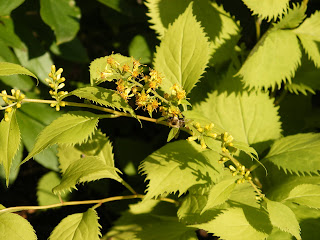
...goldenrod! These plants have gotten a bad rap over the years because people believe they cause allergic reactions. Unfortunately for the goldenrods, they have been guilty by association. Goldenrods bloom at the same time as ragweeds, which are actually responsible for the allergies. Ragweeds are wind-pollinated, hence their irritating pollen is flying around in late summer and early fall, while goldenrods are insect-pollinated. That means only the bees and other pollinating bugs are covered in that yellowy dust. What's worse, ragweed pollen grains contain a protective protein that causes a reaction in humans (i.e., sneezing). This makes its pollen extra irritating, and in response, peoples' mistaken ire with goldenrods is equally severe.
But it need not be that way! Goldenrods (genus Solidago) are a large group of tough North American natives with yellow blooms in late summer and early fall--an embodiment of late summer sunshine and the turn to fall. Some species, such as S. ulmifolia, can tolerate part shade. All will thrive in full sun. Gray's goldenrod (S. nemoralis) is barely 1' tall, while stiff goldenrod (S. rigida) and showy goldenrod (S. speciosa) can reach 3' tall or more. Some have flowers that bloom on inflorescences, others bloom atop the stem, basically the variety in this genus is huge. Once established, all goldenrods are extremely drought tolerant, and many can survive in poor soils.
I grow zigzag goldenrod (S. flexicaulis), which you see here with a bee visitor bending over one of the flower stalks.

The genus Solidago belongs to the Composite family (Compositae), which includes sunflowers, asters, and rudbeckias, to name only a few. The flowers in this family--or what we would consider the flowers--actually consist of many tiny flowers grouped into one flower head (hence, "composite"). So on my zigzag goldenrod, these flowers are composed of many teeny, tiny flowers that can barely be distinguished by the naked eye. The advantage of this trait is much higher-than-average seed production (think sunflowers).

I love this goldenrod because the stalks create a sparkler-type effect as the flower heads burst into bloom, then fizzle out along the inflorescence at different times. What's actually happening here is a funny mix of flowering styles. The teeny, tiny flowers inside each flower head bloom from the outside to the inside (what is known as "indeterminate"), but the entire stalk blooms from the top to the bottom ("determinate"). The flaring and fizzling starts at the top of these stalks and moves downward, as you can see in the above picture where the top flower heads are in full bloom with stamens popping out and the bottoms have yet to bloom. This enhances the sparkler effect.
Along with its drought tolerance, my goldenrod puts up with partial shade (more than it should be getting), root competition from the nearby red maple, and it's a bumblebee magnet. It looks nice near some other natives (my Lobelia siphilitica and Eupatorium maculatum, check out the header photo for an example), but it's actually wedged between two peonies, proving this plant can go beyond the strictly native garden.

Some goldenrods can look just plain weedy, so choose one carefully based on your site and desired aesthetic (ornamental v. prairie restoration). More hybrids and cultivars are coming out, so it's becoming easier to find ornamental species. Essentially, don't discount this genus simply because of its bad reputation. Sometimes it can surprise you!
4 comments:
I have two Goldenrods, and I love them with New England Asters. 'Fireworks' is so flashy, I think it must have your Goldenrod as one of its parents. The other 'Dandolitlem' (Little Lemon) is not as vigourous/sturdy. This is my second attempt at trying to grow it. I'm hoping the little plant will bloom.
Rose, your header is gorgeous. Thank you for all the information on goldenrods. Drought-toleratant are two words that are music to my ears with all the maple roots I contend with. A lot of stuff is being moved around here lately, and I'll be looking for a spot to try one of the more shade-tolerant varieties.
I have quite a lot of goldenrod--all of it growing voluntarily, so it's one of the taller native species. It grows up around the farm outbuildings in back, for the most part, and at the back of my Butterfly & Friends garden where it fits right in with my chaotic "scheme." It is such a pretty plant, even in its wilder form, so it's good that people learn it's not the cause of allergies.
A great post, Rose!
Thanks for defining some terms I've never gotten around to looking up, like "determinate" and "composite" and for the recommendations for different varieties. And I really like your new header!
Hello nice bblog
Post a Comment